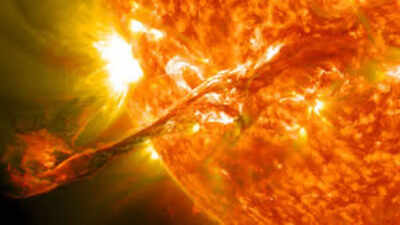ARTICLE AD BOX

A powerful
solar storm
traveling at speeds of nearly 2.1 million km/h (21 lakh kmph) has struck Earth, triggered by a rare “cannibal” coronal mass ejection (CME) where one CME overtakes another and merges into a stronger burst. The event began on August 30, 2025, when sunspot region AR 4199 produced an M2.7-class
solar flare
, followed by multiple CME eruptions in succession. The impact reached Earth late on September 1 and continued into September 2, compressing the planet’s magnetic field and unleashing
geomagnetic storms
strong enough to threaten modern infrastructure and light up skies worldwide.
What makes this solar storm unique
This storm was powered by a cannibal CME, a phenomenon where a faster ejection from the Sun catches up with a slower one, combining their plasma and magnetic fields into a more powerful eruption. This intensified the force of the blast, sending solar winds hurtling toward Earth at over 600 km/s, abruptly compressing the magnetosphere and fueling geomagnetic turbulence. Scientists noted that this event exceeded early forecasts, pushing storm levels into the G1 (minor) to G3 (strong) range with a Kp index above 6, indicating significant magnetic disturbances.
Impacts on Earth: From power grids to auroras
The immediate consequences were widespread.
Power grid
operators, particularly in high-latitude regions, went on high alert for voltage fluctuations that could trigger outages. Satellites faced risks including increased atmospheric drag, orientation issues, and electrical charging. GPS navigation and high-frequency radio signals experienced intermittent disruptions, while airlines prepared for possible communication challenges on polar routes. Yet alongside the risks came a spectacular natural display—bright
auroras
visible at unusually low latitudes. Sky watchers in North America, Europe, and Asia reported sightings as far south as New York and Germany, far beyond the normal polar regions.
Growing concern as solar cycle 25 peaks
Experts warn that such powerful space weather events are likely to increase as
Solar Cycle 25
nears its maximum in the coming months. Cannibal CMEs, with their dense plasma and enhanced magnetic fields, pose heightened risks to both terrestrial and orbital technology. Agencies like NASA and NOAA had predicted the CME’s arrival, but the storm’s intensity exceeded initial models. Utility providers and satellite operators scrambled to apply safety measures, ensuring critical systems remained stable. For scientists and space-weather forecasters, the storm offered a unique opportunity to study how Earth’s magnetic field responds under extreme conditions. For the public, it was a dramatic reminder that our planet’s technology and daily life are tightly bound to the Sun’s moods.



.png)
.png)
.png)
















 4 hours ago
3
4 hours ago
3








 English (US) ·
English (US) ·